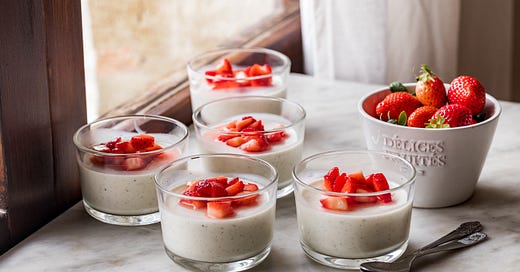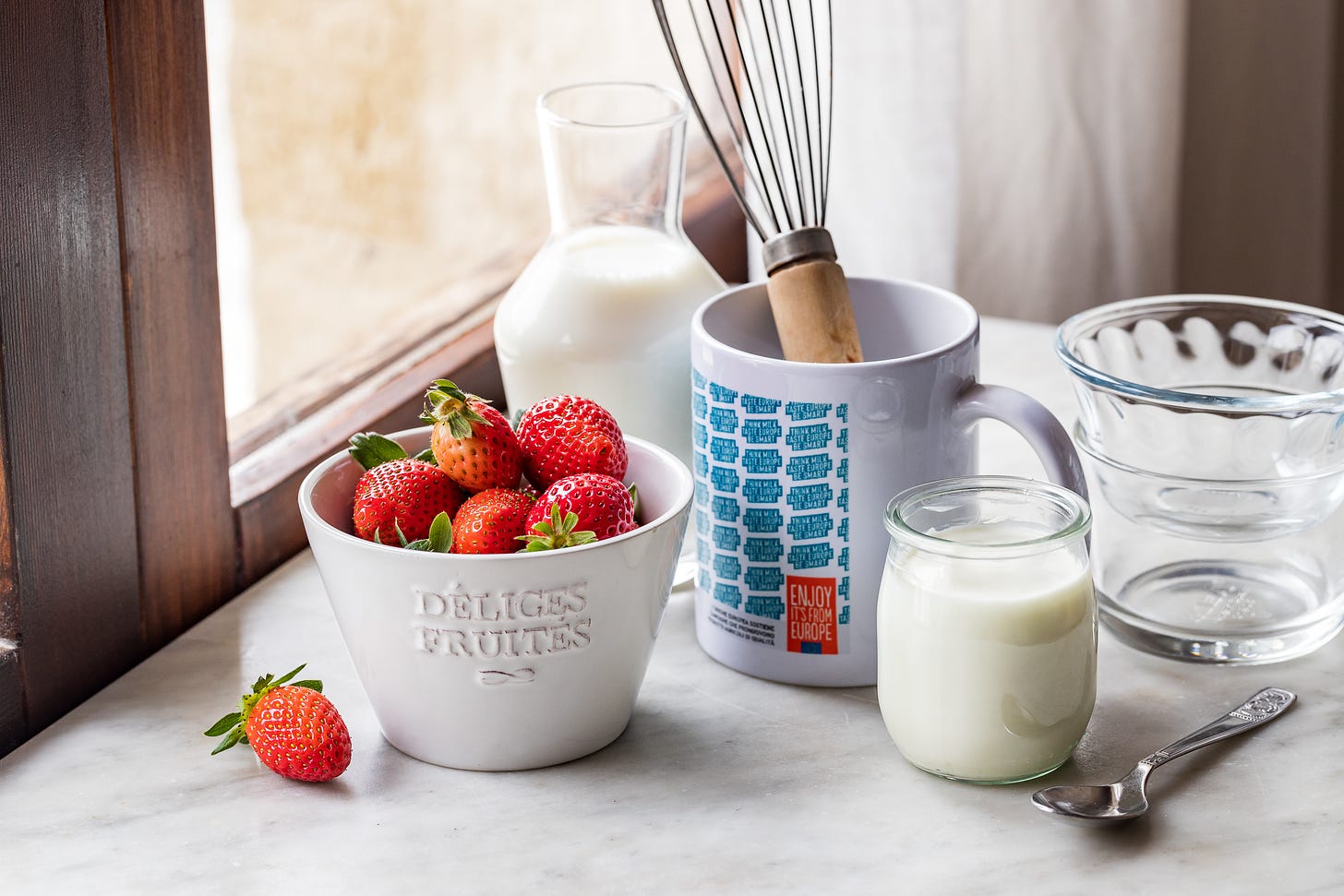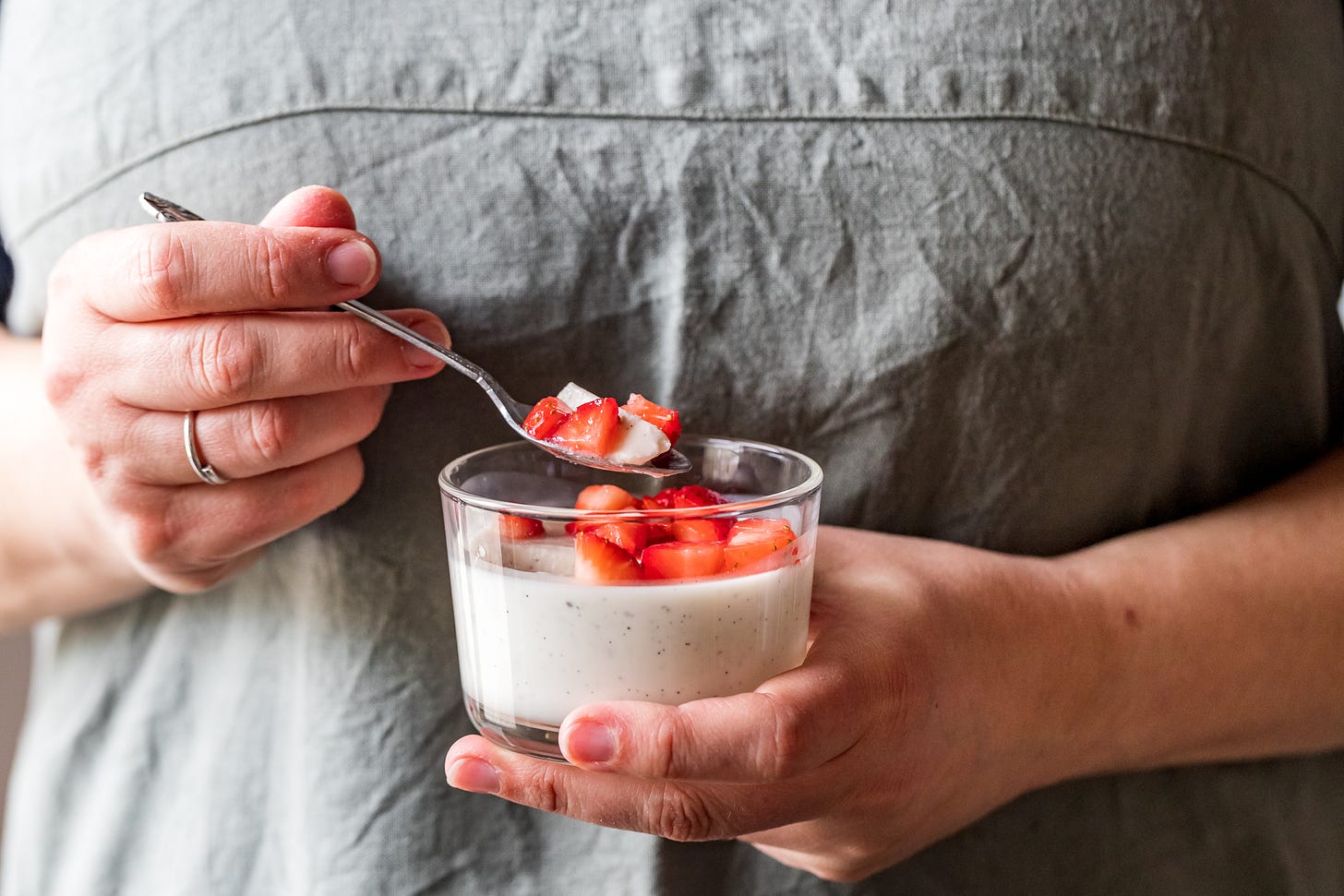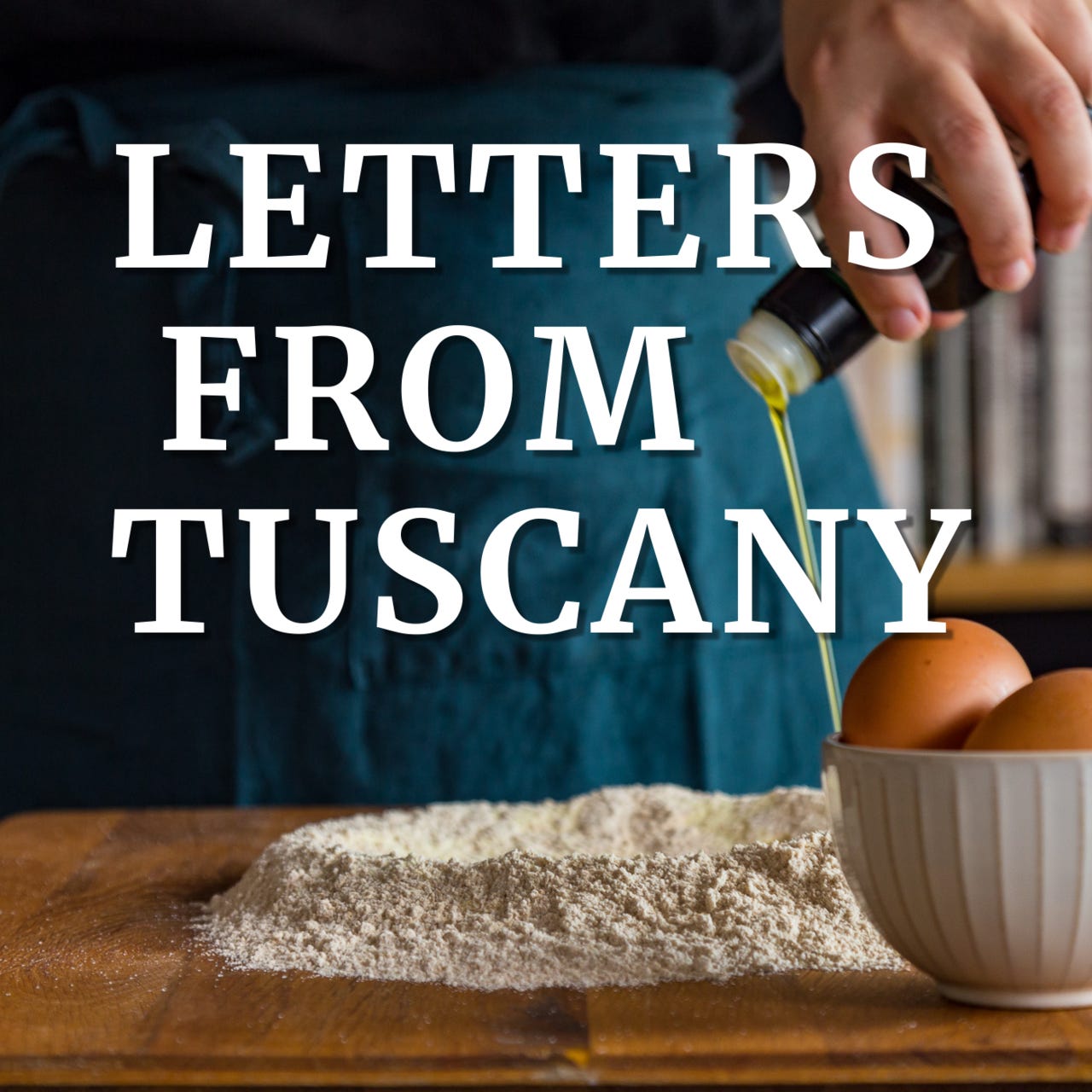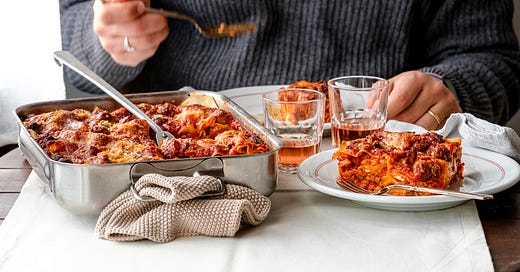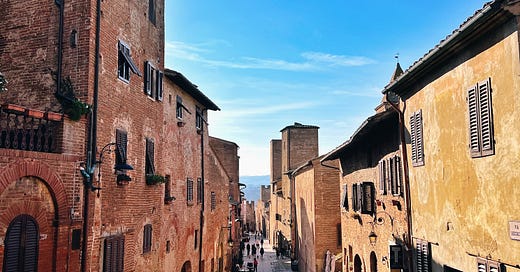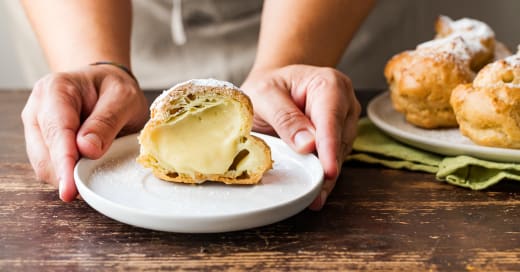Vanilla bean seeds and a good panna cotta
The yoghurt makes it lighter, refreshingly tart, the best ever made
For me, the vanilla bean seeds are an essential part of a good panna cotta. I usually use homemade vanilla extract - you just need nice fleshy vanilla pods, vodka, and several months of patience to make it - but there are very few recipes where I like to use the whole vanilla pod. Panna cotta is one of them.
It's such a basic recipe, with the shortest ingredients list, that it's worth using only the top-quality ingredients: fresh cream, whole yoghurt, very little sugar, and a single vanilla bean.
And since strawberries are finally back in season here in Italy, we can top the panna cotta with a few strawberries marinated in sugar and lemon juice, which nicely echoes the tartness of the yoghurt.
The panna cotta recipe was developed as part of the Think Milk, Taste Europe, Be Smart project, promoted by the cooperative system of the Italian dairy chain, aiming to raise awareness of the high European standards and the great tradition of dairy products in Europe. Behind a yoghurt jar, there’s a universe of traditions and customs, of skills and rules: it is a product whose quality and safety are guaranteed by European standards and mandatory traceability.
In the case of panna cotta, the yoghurt makes it lighter, refreshingly tart, the best ever made. The amount of gelatine is kept to a minimum, as the panna cotta is served directly into the glasses, thus remaining creamy.
Yoghurt panna cotta
Makes 6 glasses
To make panna cotta
8 grams leaf gelatine**
400 grams/1 ⅔ fresh whipping cream (36% fat)
50 grams/¼ cup of sugar
1 vanilla pod
200 grams/¾ cup (8 fl oz) whole milk yoghurt
**8 grams equal to 4 gelatine sheets.
To top panna cotta
200 grams/7 oz strawberries
1 tablespoon sugar
Juice of ½ lemon
Place the gelatine sheets in a shallow bowl, cover them with cold water, and soak them until the gelatine turns transparent and soft.
Pour the cream into a small saucepan, add the sugar and the seeds of the vanilla pod. Stir to dissolve.
Heat the cream on medium flame and turn off the heat when it comes to a boil.
Squeeze the soaked gelatine sheets to remove excess water and add them to the saucepan with the cream. Whisk to dissolve the gelatine, then stir in the yoghurt.
Pour the cream and yoghurt mixture into six small glasses, collect them in a tray and cover them with foil. Transfer the panna cotta to the fridge and refrigerate until the next day.
The next day, prepare the strawberries to top the panna cotta.
Wash the strawberries under running water, pat them dry, remove the leaves and cube them. Collect the cubed strawberries into a small bowl. Add the sugar and lemon juice and mix well. Leave them to macerate for at least an hour.
Before serving the panna cotta, spoon the strawberries with their juice into the glasses and serve.
If you’re planning to make this yoghurt panna cotta, share the results with us on social media by using the hashtag #myseasonaltable and tagging @julskitchen on Instagram.
If you have questions about the ingredients or the recipe, if you have a special request for one of the following cooking projects, or want to have a chat, reply to this email or leave a comment.
More recipes with yoghurt
The same old tortelli, but with something unusual, at least for me. Working on the filling, I replaced ricotta with strained yoghurt, then I followed tradition, and mixed it with spinach sautéed in butter, grated Parmigiano Reggiano, nutmeg, and marjoram.
Citrus Yoghurt Cake. This yoghurt cake, made using the yoghurt pot as a measuring cup, is the easiest bake you can imagine. Use high-quality ingredients: fresh free-range eggs, organic full-fat yoghurt and seasonal fruit. In winter, you can mix in the grated organic orange peel to give an extra hint to your cake. Eaten for breakfast, this cake will turn your mornings into a glorious moment.
Link love
Difference Between Vanilla Extract, Vanilla Beans, and Vanilla Pods. Vanilla’s intense aroma is completely unique, and best experienced in the whole-pod form
How to use gelatin, by David Lebovitz. Read also Gelatine leaves to powder conversion, by Nigella Lawson.
Support us by joining our paid newsletter
[If you already subscribed to our newsletter, thank you!]
When you join our subscription-based newsletter, you are actively contributing to the making of Letters from Tuscany, granting us the time, energy, and resources to research, test and re-test, and photograph the recipes, to write the stories and the interviews, to film the videos that we share here. You are part of the reason why we keep cooking, writing, and sharing, so thank you.
What you missed recently: Bow-tie fresh green and yellow fresh pasta with peas, prosciutto, and cream, Florentine rice fritters, Pasta alla puttanesca, Ciaccino with ham and mozzarella.
Whenever you decide to join us, you will have complete access to the whole archive of already published recipes and stories.
Let me tell you a secret…
…where I buy my vanilla pods.
Vanilla has risen dramatically in cost over the last few years, but I strongly object to using powdered vanillin - it has that chemical, tingling taste that lingers at the back of the throat - not to mention buying vanilla pods at the supermarket, which are definitely not worth the cost.
The turning point came when I met one of the Francesco's behind FVM - Organic vanilla, Letizia’s husband, one of Tommaso’s oldest friends. While chatting amiably at dinner, he incidentally mentioned he had a vanilla plantation in São Tomé. My eyes sparkled.
For years now, I have only been getting my supplies from him: organic fair-trade vanilla, fresh, fragrant, a fabulous ingredient for every pastry recipe.
If you want to buy incredibly fresh and aromatic vanilla pods, contact him directly on Instagram.
Every year I use the vanilla pods I buy from Francesco to prepare home-made vanilla extract - all you need is vodka, vanilla pods and time - and then I use the other pods sparingly: the seeds go into custards, pastry cream, or panna cotta, while the used pods are stashed into a jar of sugar to naturally flavour it.
Once the pods are dry, I blend them with sugar and make vanilla-flavoured icing sugar: in short, I don't waste a single piece.
The new Substack App!
I have exciting news to share: You can now read Letters from Tuscany in the new Substack app for iPhone.
I have been waiting for this feature since I started reading many newsletters: I wanted an app where I could easily read all my favourite food writers, and now, there it is!
With the app, you’ll have a dedicated Inbox for my Substack and any others you subscribe to. New posts will never get lost in your email filters or stuck in spam. Longer posts will never be cut-off by your email app. Comments and rich media will all work seamlessly. Overall, it’s a big upgrade to the reading experience.
The Substack app is currently available for iOS. If you don’t have an Apple device, you can join the Android waitlist here.

